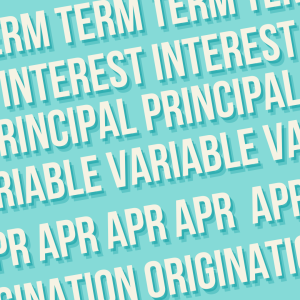
1. Principal
The principal is the initial amount of money borrowed from a lender. It’s the baseline amount upon which interest accrues. For example, if you take out a loan for $10,000, the principal amount is $10,000.
2. Interest
Interest is the cost of borrowing money, expressed as a percentage of the principal amount. It’s the compensation the lender receives for taking on the risk of lending money. Interest rates can be fixed, meaning they remain constant throughout the loan term, or variable, meaning they can change based on market conditions.
3. Term
The term refers to the length of time over which the loan is scheduled to be repaid. It’s usually expressed in months or years. For example, a 5-year loan has a term of 5 years.
4. Annual Percentage Rate (APR)
The APR represents the total cost of borrowing over a year, including interest and any additional fees. It’s expressed as a percentage of the loan amount. The APR provides borrowers with a standardized way to compare loan offers from different lenders.
5. Amortization
Amortization is the process of paying off a loan through regular installments, which include both principal and interest, over a predetermined period. With each payment, a portion goes toward reducing the principal balance, while the rest covers interest charges.
6. Collateral
Collateral is property or assets that a borrower pledges to a lender as security for a loan. If the borrower defaults on the loan, the lender can seize the collateral to recover their losses.
7. Secured Loan
A secured loan is a loan that is backed by collateral. Because the lender has a form of security, secured loans typically have lower interest rates than unsecured loans.
8. Unsecured Loan
An unsecured loan is a loan that is not backed by collateral. Since the lender takes on more risk, unsecured loans often have higher interest rates than secured loans.
9. Fixed-Rate Loan
A fixed-rate loan is a loan with an interest rate that remains constant throughout the term of the loan. Fixed-rate loans provide borrowers with predictable monthly payments.
10. Variable-Rate Loan
A variable-rate loan is a loan with an interest rate that can fluctuate over time. The interest rate is usually tied to a benchmark rate, such as the prime rate, and can change periodically.
11. Origination Fee
An origination fee is a fee charged by a lender for processing a new loan application. It covers the cost of underwriting and processing the loan.
12. Closing Costs
Closing costs are fees and expenses incurred by the borrower during the loan closing process. They can include appraisal fees, title insurance, attorney fees, and other expenses associated with finalizing the loan.
13. Prepayment Penalty
A prepayment penalty is a fee charged by some lenders if the borrower pays off the loan before the scheduled term ends. It’s designed to compensate the lender for lost interest payments.
14. Grace Period
A grace period is a period of time after the due date during which a borrower can make a payment without incurring late fees or penalties.
15. Default
Default occurs when a borrower fails to meet the terms of a loan agreement. This could involve missing payments, violating other conditions of the loan, or failing to maintain required insurance coverage.
16. Forbearance
Forbearance is a temporary postponement or reduction of loan payments granted by a lender to a borrower facing financial hardship. It allows the borrower to avoid defaulting on the loan temporarily.
17. Deferment
Deferment is a period during which a borrower is not required to make payments on a loan. It’s typically granted for specific reasons such as enrollment in school, military service, or experiencing economic hardship. Interest may or may not continue to accrue during deferment, depending on the type of loan.
Understanding these terms can help you make informed decisions when taking out loans and managing debt. Contact Treasury Funds Home Loans, Inc. for any and all of your mortgage loan questions and/or needs.
